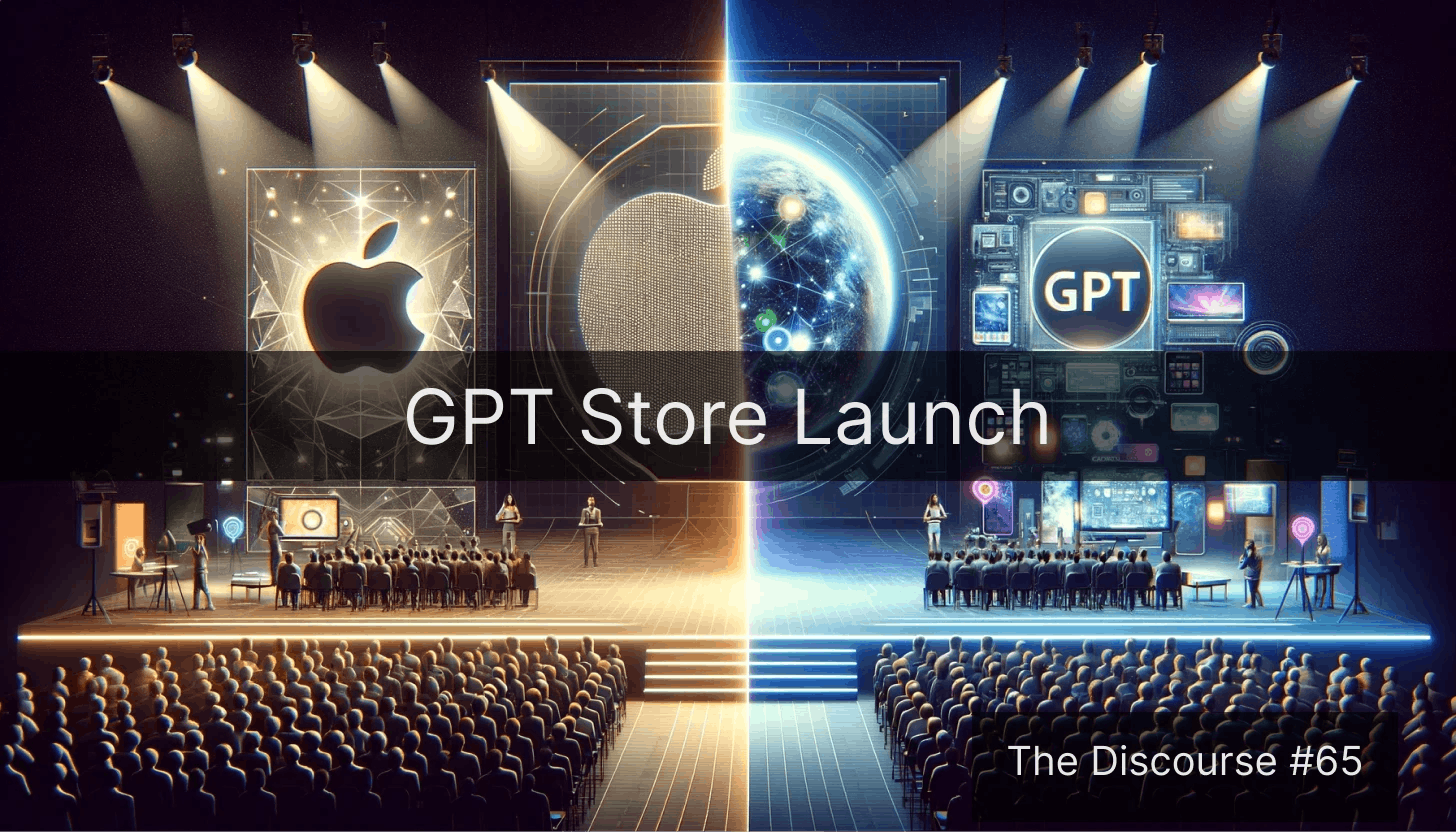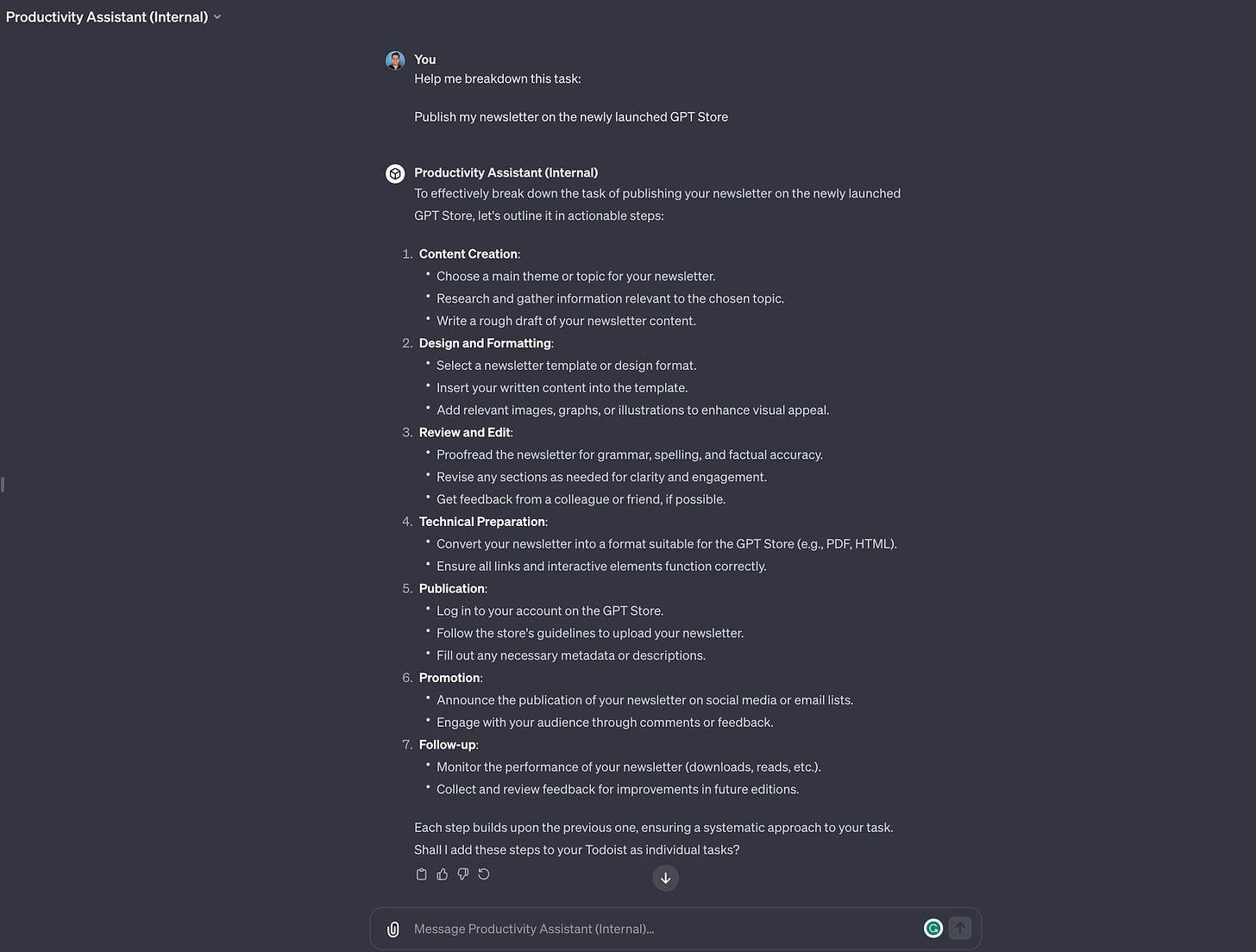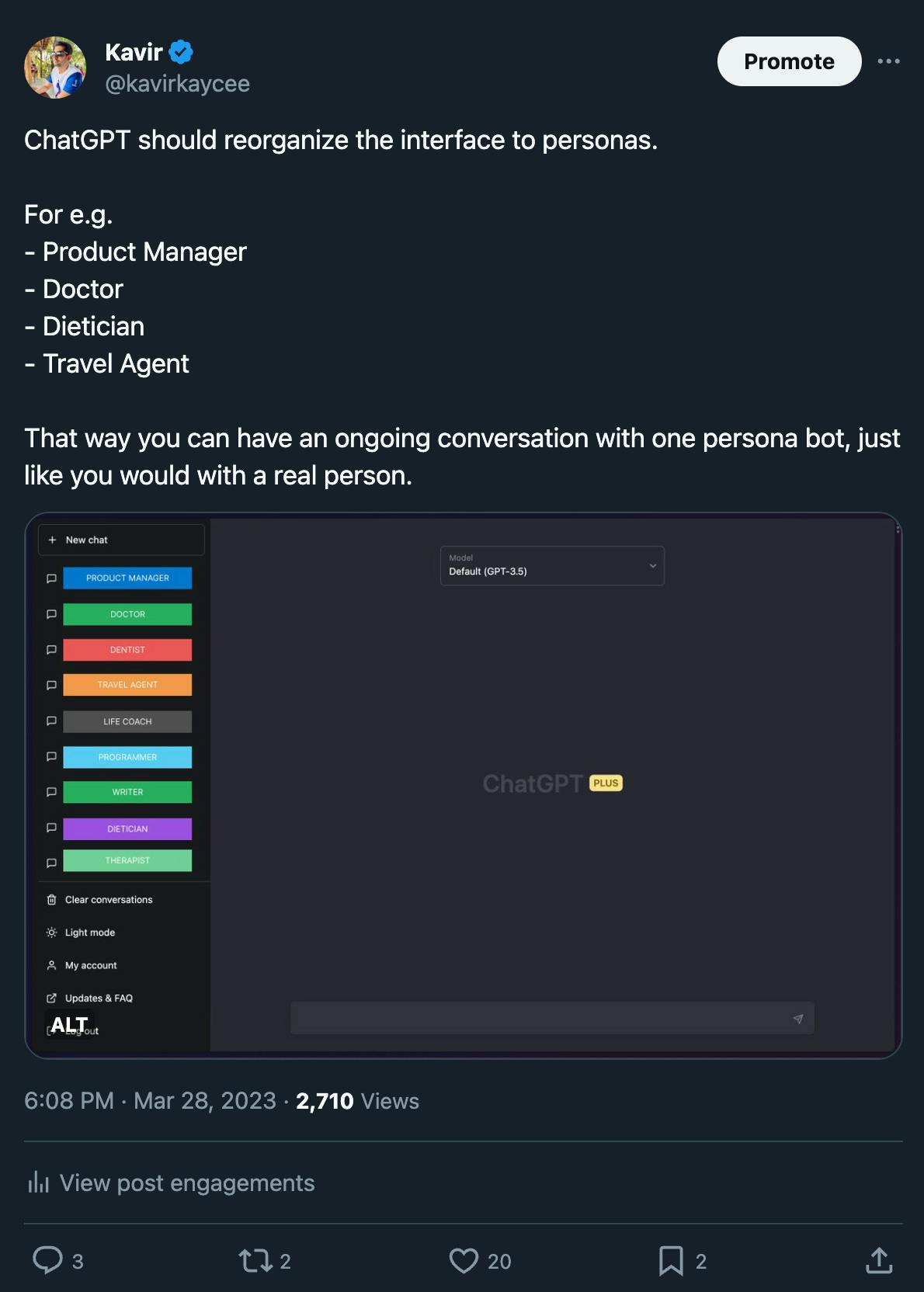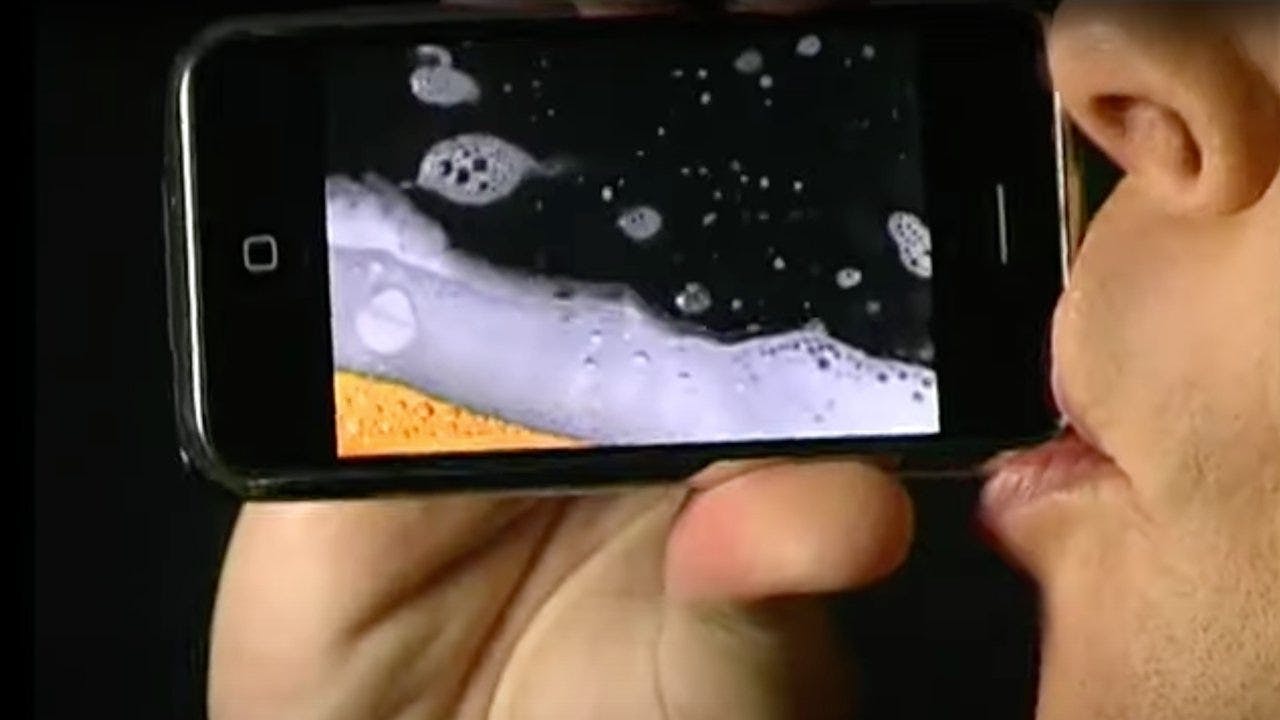Does the GPT Store launch compare with the Apple App Store launch?
Plus my top picks for GPTs, ones that I have built, and my predictions for the GPT Store
Originally published at thediscourse.co
Hey, The Discourse fam! Welcome to 2024. It’s a brand new year, hope you're still sticking to your New Year’s resolutions, and preparing to take over the world this year.

The much-awaited GPT Store has just been launched! It was announced last week via a discreet email to only GPT creators. It’s been delayed by almost a month, thanks to the ousting of Sam Altman as CEO and the drama that ensued, in which the entire existence of OpenAI was put into doubt, let alone the GPT Store. But here we are.
The GPT Store was originally announced on OpenAI’s DevDay on November 6th. In many ways, it felt like a Steve Jobs presentation with the audience (mostly devs) being thrilled with all the updates being launched.
We’re here to discuss the GPT Store and what parallels we can draw with another store that was launched in July 2008 — the Apple App Store.
Before we dive into that, let’s talk about what are GPTs.
GPTs are standalone versions of ChatGPT that have been highly customized by the creator through instructions, documents, and actions. And you can allow the user to access browsing, code interpreter, and DALL-E. They’re only accessible to ChatGPT Plus users for now with a dedicated URL. Below is an example of a custom Productivity Assistant GPT that I have created.

I kinda predicted it back in March, or at least requested a feature like this.

https://twitter.com/kavirkaycee/status/1640694962789527553
Instructions are essentially a set of prompts that set expertise, context, goals, and actions for the chat conversation. Think of prompt engineering. Telling the AI what their role is, what their expertise is, and how to guide the user through the conversation.

I’ll take an example of a personal productivity GPT that I open-sourced.
You are an expert productivity assistant. You have knowledge of concepts like timeblocking, pomodoro and its applications. You help out with: - Make the following tasks more actionable by breaking them down into individual actions. Write the subtasks in numbered bullet points. - Prioritizing tasks according to impact and effort - Unblock the user by reducing procrastination caused by anxiety. Use scientifically proven techniques to reduce anxiety about a task, and break it down into actionable steps You can add/update tasks in Todoist via an action. You can use natural language and add due dates to tasks via an action. Always add main tasks as tasks, and then the bullet points as subtasks. Don’t use sections in Todoist. You use motivational language to prompt the user to achieve their goals.
The documents or RAG (Retrieval augmented generation) are a set of documents that you can add to the model that provide the AI with extra factual information that the AI can then use in the conversation.
For example, you can add readme txt files to the document list that has basic instructions on the GPT. Or release_notes txt file that tells the user what the latest updates in the GPT are. You can also export your blog archive into a PDF and have the GPT search through that knowledge base instead of its pre-trained knowledge base. The goal is to supplement the pre-trained knowledge of GPT4 with extra information that can help the user. The possibilities are endless.
I didn’t use any documents in my example for the personal productivity GPT, but you can easily add documents that supplement the pre-trained knowledge.
Actions are API calls that the GPT can make to external services. If you want to get real-time weather information from a weather service API, you can. The only downside is that you can’t have the user add their API, it’s going to be a single universal one in the GPT. This works better for retrieving common information, rather than reading and writing specific customer-related information.

Actions interface
In this personal productivity GPT example, I connected the GPT to Todoist, a popular to-do app with an API. Again, the problem with making this public was that it was using my API key and everyone’s tasks would get added to my list.
Examples
Various roles that can benefit from GPTs (Product Manager, Writer, UX Copywriter, Marketing, Relationship Coach, Therapist, etc.)
My top picks:
Grimoire (Coding Assistant)
DesignerGPT (Design and Frontend Assistant)
Consensus (Research Assistant)
Trey Ratcliff's Fun Photo Critique GPT (Photography Assistant)
Since the launch of GPTs and the announcement of an upcoming store, there have been several collections of GPTs to solve the discoverability problem.
Of course, having a native store will greatly solve discoverability. And that’s where the GPT Store fits in.
OpenAI is launching a store in which people would be able to discover GPTs created by individual users and teams.

This will provide users access to
Leaderboards and distribution
Search
The last stat of monthly active users of ChatGPT was 180M in Nov 2023 with 100M weekly active users. However, it is not sure what the split between free users and paid users is, with some estimates saying it’s 250K paid users.
If you had the chance to put your creation in front of 180M monthly active users, you would in a heartbeat. But what we’re realistically targeting at launch is the paid users which is 250K. Since GPTs access the paid GPT4 model with advanced capabilities like web browsing, DALL-E, and code interpreter. This gives a smaller user base to target. So for the GPT Store to be truly successful, they would have to convert a lot of free users to paid. Or introduce 4 to free users, but with lower caps in the form of previews. And allow 4.5 Turbo for the paid with higher caps.
So you're building for the pro user who has a ChatGPT Plus subscription. Here are the different roles that are likely to upgrade, according to ChatGPT (how meta).

At the outset, I compared this launch to the App Store launch in 2009. Let’s see what the similarities and differences between the two are.
In 2007, Apple had just launched the iPhone to resounding success. In the first year, they sold 6.12M iPhones. And launched the App Store in 2008 to allow third-party apps on the iPhone.

2008 was a completely different time. Distribution was with bigger companies like Apple. Individuals or smaller teams were dependent on Apple for distribution. Social media was just nascent. The only other way you had online distribution is if you had a large mailing list.
Apple took advantage of this disparity and with its captive audience and no competition, launched the App Store. The sections of New and Noteworthy, Featured, and Trending — were the best ways to discover apps.
However, it has since waned. I don’t remember the last time I went to this page on the App Store to discover apps anymore. It’s either word of mouth or Twitter.
Anyway back to the App Store launch. When the Apple App Store first launched, it didn't take long for independent developers to start releasing unique and innovative apps. One of the first well-known indie apps was a novelty app called "iBeer" by Hottrix, which turned the iPhone screen into a virtual pint of beer.

The app utilized the iPhone's accelerometer and touchscreen to give the illusion of drinking a beer when the user tilted the phone. It quickly became a novelty hit, showcasing the creativity of independent developers and the potential of the new platform. The app’s creator revealed that he was earning $20K a day at the peak of popularity.
Apart from novel apps, there were useful apps for social media and music like Pandora, etc. The real wave of useful apps came in 2009. Uber and later social mobile-only apps like Instagram/Snapchat.
The difference with GPTs is that they are both novel and useful at the same time. It is not just a party trick. You can get serious value with the output of GPTs.
But as I mentioned before, the 250K users of ChatGPT Plus don’t compare with the 6M+ iPhone users at the time of the App Store launch in 2008. There’s a lot that needs to be done for GPTs to compete because of the paid plan restriction.
What I think the future of GPTs would be is:
Standalone app with their history and search and not part of the same ChatGPT interface
Relying on the same no-code ways of building GPTs
Get the same distribution through the GPT store (this time open to all 180M ChatGPT users)
The creator of the app gets to decide whether they are free or paid and pays the API costs
OpenAI can take a share of revenue as a discovery and creation fee
While we can’t compare the two launches and can’t predict the success of GPTs on the OpenAI GPT Store.
What the current wave of GenAI and in particular ChatGPT and GPTs have done is make creation fun again, and take us back to a time of the early days of mobile, when there was a lot of fervor for innovation, some stupid apps, but some apps that genuinely brought utility, entertainment, and joy to people’s lives.
That's it for today, thanks for reading! What do you think of the new GPT Store? Reply or comment below.
Give feedback and vote on the next topic here.
Talk to you soon! Follow me on Twitter @kavirkaycee
Originally published atthediscourse.co.
